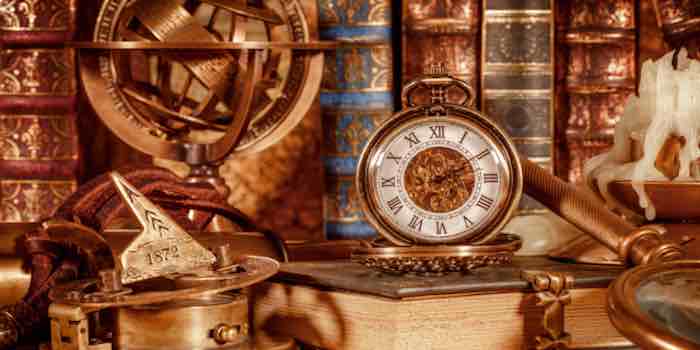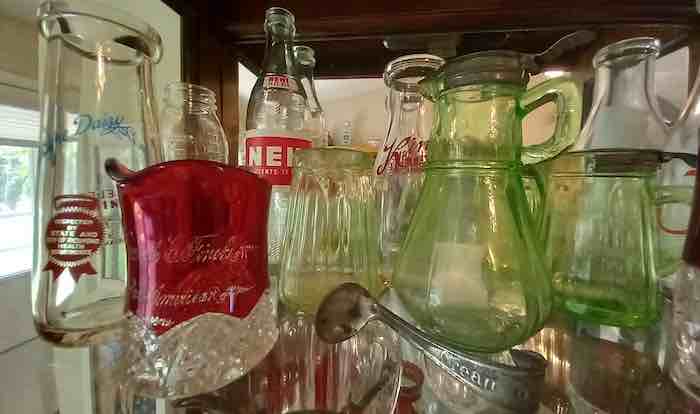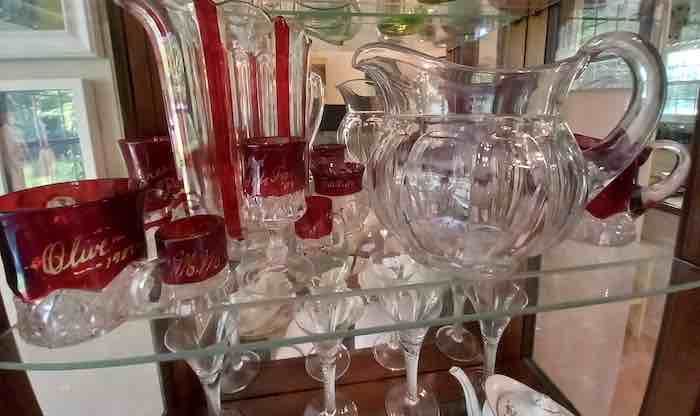By Dr. Bruce Smith ——Bio and Archives--July 26, 2023
HeartlandLifestyles | CFP Comments | Reader Friendly | Subscribe | Email Us

Any kind of interest in the past has the potential to enrich our lives in more ways than we might suspect. To my way of thinking, an antique shop is like a little museum.
Of course, not all museums are alike. There are museums of things that don’t interest me, like umbrellas and dentistry. There’s a museum of moist towelettes. At the present time, it isn’t on my bucket list.
There are museums of things or people that annoy me. Take abstract art or the George Bernard Shaw birthplace museum. Nope. Not going there.
There are private museums like the Ashmolean museum at Oxford and the Frick in New York. Now the Frick Museum is definitely on my bucket list. It’s one of the great art museums in the world, and Frick is a personal hero of mine to boot. I could get lost in there, and I’d write his biography if they’d let me. One of the greatest private museums is the Cedar Rapids Museum of Art, which focuses on the works of Grant Wood. It’s worth a trip from anywhere on the planet.
Then there are public museums, funded indirectly, at least, by taxpayers. The National Gallery and the Smithsonian Museum in Washington are examples of these. I’ve been to both of those and hope to get back there soon. At the National Gallery you can see Vermeer’s Girl with a Red Hat. It’s breathtaking.
Antique shops are the same way. Some are amazing because they have lots of the things I like. My favorites will have ruby glass, old tools, old product tins and enameled signs, industrial machinery, or kitchen and bathroom artifacts. Furniture from the late 19th and early 20th centuries hold a special fascination, as do farm-related antiques. Others seem to contain mostly cheap glassware, uninspiring decorative items, and stuff that looks like it really should have made a trip to the landfill, but that’s just me.
Thrift shops are a kind of hybrid cross between antique shops and yard sales. They can be repulsive or magnetic. I know of one that regularly has amazing antiques but no one on staff who recognizes their real value. No, I’m not telling anyone where it is.

Interest in the past via antiques goes way back on the Smith side of the family. My dad’s crazy cousin had an antique shop in Cambridge City, Indiana in the 1950s and very early 1960s. He was a coin and gun collector and dealer. He went to auctions and estate sales and bought and sold most anything of value. He and his wife had a motor court on the east side of town and she had an elegant dress shop.
He had been a policeman in Detroit in the 1930s and he could tell some stories.
He liked his big cars. He had owned a Stutz Bearcat back in the 1920s, but his collections and his car interests came together in 1958 when he bought a new Chrysler Imperial using only bags of dimes. That story made the Indianapolis papers and brought him eccentric notoriety. I heard him tell the tale many times. I’ll bet you don’t know of anyone else who did that. Neither did we. It was probably from this deep family interest in old things that made me aware of how interesting antiques could be.
More directly, my interest in antiques came from the folks. One day about 1961 my dad brought home an Eastlake wash stand. It was walnut, was from a shop, and had a beautiful marble top. Painted white, when I first saw it, he stripped the paint and refinished it with a clear oil finish which made it glow with warm, rich brown. It had the original little pendulum pulls that marked it as an Eastlake piece from about 1895. There were Auntie’s tiny little silver spoons my mother proudly displayed on a spoon rack on the wall in the dining room. The handles were engraved WBP, which made no sense to me. A little later on I asked about the initials and in doing so learned that Auntie’s first name was Willie! She was born a Bahon, so that explained the B. The P was for Palmer, her married surname.
Support Canada Free Press

Other antiques accumulated slowly in our house over the years. My mother wanted a big copper kettle, so my dad found one for her. It would have held 40 gallons of liquid or more. She loved it. It was the repository for magazines and newspapers in our living room and went with them wherever they lived for more than 50 years. I always thought it would have been far better to make apple butter in it, but that never happened. There was a hand-cranked Victrola my brother saved from certain destruction when he was in high school. It actually worked and became a treasured item for me. There was the rattan platform rocker Uncle had used for years. There were dishes and other objects handed down, like the mantel clock that was a gift to my great grandparents for their wedding in 1899.
My own interest in history built on this background. I began to notice American domestic architecture when I was still in high school. That interest developed into a fascination with American social history, and that led me to American economic history. All of these things made a foundation for my oral history work. From that combination came my book, The War Comes To Plum Street.
By the time I was in high school and able to drive, I began to go into antique shops now and then. With a farm background, I began to look for old farm tools and artifacts as I drove across the countryside. When I was in high school and driving for the dry cleaners, I spotted some interesting farm objects at a place in Ohio. I stopped in and introduced myself. “Are any of those milk cans over there by the fuel tank for sale?” “Sure,” the old boy said, a little puzzled. “Take your pick for ten bucks.” I don’t think I tried to negotiate like I certainly would now. I looked them over and picked the one with big pressed letters that read HOOD REGISTERED 1955. It had come all the way from New England, I later found out. I still have it. At the time, it would have cost me three or four days’ pay. What a deal!
With a car interest and a brother who was an auto mechanic, I began to look for old cars behind barns or abandoned in neglected fields. I found a 1950 Plymouth wagon in a barn in Ohio. There was my first old car boneyard where I saw old Dodge Brothers sedans and a Chevrolet sedan with a bowtie on the little hubcaps on the wood spoke wheels. At a scrap yard I drove past on the way home from school, two Model T Ford coupes from about 1924 appeared one day, pulled out of a barn somewhere. I asked, but couldn’t afford either one on my minimum wage job. I drove a 1937 Plymouth that had also come out of a barn after a long sleep.
Scrap yards are little museums, too. One guy in my high school graduating class came from a family that was in the junk car and auto parts business. He drove a silver Jaguar XKE to school. Another classmate came from the big auto parts dealer in town. He drove a 1926 Dodge sedan to school every day. The benefits of family connections! Junkyards, like cemeteries and antique shops, are fascinating places.
And so the history interest in me grew and grew. In my college years I made it a point to go to antique shops in unfamiliar parts of the country. A friend and I used to go to shops all along the old National Road from Maryland to Indiana. There were chairs and wonderful Heisey glass and my old favorite, ruby glass. Pink and green depression glass, little salt cellars, husking pegs, wooden bowls, enamel signs for Olga Pocahontas coal, Chief Paints, Sakrete, hotels long demolished, and Hires Root Beer all held sway in my mind at one time or another
Finding the old Spencerian handwriting instruction books at a shop in northern Indiana led me to solve the cursive writing difficulty that I, along with millions of other boys, struggled with in grade school. With the Spencer brothers as inspiration that it was possible, I eventually created my own cursive writing workbooks under the SmithHand Writing Methods rubric. I’ve sold them in every state and around the world.

I have some regrets. There was a shop in Washington, Pennsylvania that had that perfect little round coal stove that had come out of a caboose from the Pennsylvania Railroad. The PRR logo was cast right into the top. It looked like it was barely used and the price was decent. The problem would have been to get it into the trunk of that ’64 Toyota Corolla. Alas, we drove off without it. I’ve never seen another one. If I had only gotten it that day, moved it 23 times, kept it from rusting, and brought it to my present workshop, it would be a prize possession. Oh, well
Interest in the past, wherever we find it, gives us perspective on the present and keeps our interests keen. Those antique shops are filled with semi-random collections of reminders of the past. When we go inside, if we’re lucky, we rediscover that things have not always been the way they are today. We may also be inspired to learn from the past and use it to improve our own world. Sometimes we might just copy an idea. There is nostalgia and beauty to be discovered and admired and also kitsch to sometimes embarrass us. Those reactions can help us establish and maintain our values and tastes as they guide us to the future. With luck, that future will be rich with physical objects serving as reminders of an interesting past. Such reminders may be found in antique shops, junkyards, old barns, thrift shops, cemeteries, and proper museums. I may run into you coming around the corner where the player piano rolls and the Blackhawk corn shellers are waiting for us.

View Comments
Dr. Bruce Smith (Inkwell, Hearth and Plow) is a retired professor of history and a lifelong observer of politics and world events. He holds degrees from Indiana University and the University of Notre Dame. In addition to writing, he works as a caretaker and handyman. His non-fiction book The War Comes to Plum Street, about daily life in the 1930s and during World War II, may be ordered from Indiana University Press.